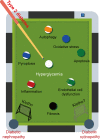Klotho's impact on diabetic nephropathy and its emerging connection to diabetic retinopathy
- PMID: 37143722
- PMCID: PMC10151763
- DOI: 10.3389/fendo.2023.1180169
Klotho's impact on diabetic nephropathy and its emerging connection to diabetic retinopathy
Abstract
Diabetic nephropathy (DN) is the leading cause of end-stage renal disease worldwide and is a significant burden on healthcare systems. α-klotho (klotho) is a protein known for its anti-aging properties and has been shown to delay the onset of age-related diseases. Soluble klotho is produced by cleavage of the full-length transmembrane protein by a disintegrin and metalloproteases, and it exerts various physiological effects by circulating throughout the body. In type 2 diabetes and its complications DN, a significant decrease in klotho expression has been observed. This reduction in klotho levels may indicate the progression of DN and suggest that klotho may be involved in multiple pathological mechanisms that contribute to the onset and development of DN. This article examines the potential of soluble klotho as a therapeutic agent for DN, with a focus on its ability to impact multiple pathways. These pathways include anti-inflammatory and oxidative stress, anti-fibrotic, endothelial protection, prevention of vascular calcification, regulation of metabolism, maintenance of calcium and phosphate homeostasis, and regulation of cell fate through modulation of autophagy, apoptosis, and pyroptosis pathways. Diabetic retinopathy shares similar pathological mechanisms with DN, and targeting klotho may offer new insights into the prevention and treatment of both conditions. Finally, this review assesses the potential of various drugs used in clinical practice to modulate klotho levels through different mechanisms and their potential to improve DN by impacting klotho levels.
Keywords: chronic kidney disease; diabetic nephropathy; diabetic retinopathy; drug; klotho; mechanism; type 2 diabetes mellitus.
Copyright © 2023 Tang, Zhang, Wu, Lin, Lv, Zhao, Xu, Huang and Li.
Conflict of interest statement
The authors declare that the research was conducted in the absence of any commercial or financial relationships that could be construed as a potential conflict of interest.
Figures




Similar articles
-
Sustained Klotho delivery reduces serum phosphate in a model of diabetic nephropathy.J Appl Physiol (1985). 2019 Apr 1;126(4):854-862. doi: 10.1152/japplphysiol.00838.2018. Epub 2019 Jan 3. J Appl Physiol (1985). 2019. PMID: 30605400 Free PMC article.
-
Klotho attenuates diabetic nephropathy in db/db mice and ameliorates high glucose-induced injury of human renal glomerular endothelial cells.Cell Cycle. 2019 Mar-Apr;18(6-7):696-707. doi: 10.1080/15384101.2019.1580495. Epub 2019 Mar 17. Cell Cycle. 2019. PMID: 30784349 Free PMC article.
-
Astragaloside IV protects against podocyte apoptosis by inhibiting oxidative stress via activating PPARγ-Klotho-FoxO1 axis in diabetic nephropathy.Life Sci. 2021 Mar 15;269:119068. doi: 10.1016/j.lfs.2021.119068. Epub 2021 Jan 18. Life Sci. 2021. PMID: 33476631
-
Antiinflammatory Actions of Klotho: Implications for Therapy of Diabetic Nephropathy.Int J Mol Sci. 2021 Jan 19;22(2):956. doi: 10.3390/ijms22020956. Int J Mol Sci. 2021. PMID: 33478014 Free PMC article. Review.
-
Klotho antiaging protein: molecular mechanisms and therapeutic potential in diseases.Mol Biomed. 2025 Mar 22;6(1):19. doi: 10.1186/s43556-025-00253-y. Mol Biomed. 2025. PMID: 40119098 Free PMC article. Review.
Cited by
-
Hypertension modifies the association between serum Klotho and chronic kidney disease in US adults with diabetes: a cross-sectional study of the NHANES 2007-2016.Ren Fail. 2025 Dec;47(1):2498089. doi: 10.1080/0886022X.2025.2498089. Epub 2025 May 5. Ren Fail. 2025. PMID: 40324899 Free PMC article.
-
Therapeutic potential of Cordyceps militaris cultivated with Ginkgo biloba seeds for alleviating western diet-induced type 2 diabetes and diabetic nephropathy.Front Pharmacol. 2025 May 29;16:1562116. doi: 10.3389/fphar.2025.1562116. eCollection 2025. Front Pharmacol. 2025. PMID: 40510419 Free PMC article.
-
The Association Between Weight-Adjusted-Waist Index and S-Klotho Levels in Adults: NHANES 2007-2016.Food Sci Nutr. 2025 Jul 17;13(7):e70487. doi: 10.1002/fsn3.70487. eCollection 2025 Jul. Food Sci Nutr. 2025. PMID: 40678338 Free PMC article.
-
Anti-Inflammatory Role of the Klotho Protein and Relevance to Aging.Cells. 2024 Aug 24;13(17):1413. doi: 10.3390/cells13171413. Cells. 2024. PMID: 39272986 Free PMC article. Review.
-
Macrophage Depletion Alleviates Immunosenescence in Diabetic Kidney by Modulating GDF-15 and Klotho.Int J Mol Sci. 2025 Apr 23;26(9):3990. doi: 10.3390/ijms26093990. Int J Mol Sci. 2025. PMID: 40362229 Free PMC article.
References
Publication types
MeSH terms
Substances
LinkOut - more resources
Full Text Sources
Medical

